The Only Way to Ultimately Eliminate Suffering
Jinwoo Seunim, President of the Jogye Order of Korean Buddhism
Text by. Baksa Photo by. Ha Ji-kwon
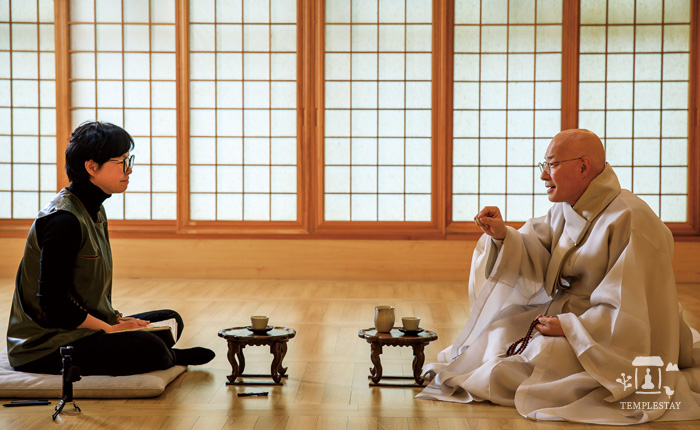
I look at Jogyesa Temple as I stand in the rain waiting for the signal at the crosswalk. It is a lively temple that one should visit at least once while in Seoul, whether you are Buddhist or not. For a while, I even passed through the temple compound deliberately on my way to other places to take care of things just because I liked the Chinese scholar tree in the temple courtyard. The temple is lit up inside and out with lotus lanterns in spring and chrysanthemums in fall. I wonder if Jinwoo Seunim was one of the monks I had met and greeted with palms together previously while walking through the temple. The crossing light turns green.
It rained at Tongdosa Temple on the day I first met Seongpa Seunim for an interview. It also rained at Chukseosa Temple on the day I met Muyeo Seunim.
On a rainy day a temple has a different sort of charm than on sunny days. A line from the Beopseongge (Song of Dharma Nature) comes to mind.
“The treasure that fills the space to benefit living beings falls like rain, and each living being receives it according to their own vessel.”

A Book Changes One’s Fate
There once was a six-year-old boy, the only child of three generations of a wealthy family who lived in Gangneung. The boy’s grandmother brought him to the temple one day, and Dongheon Seunim, the abbot of Jeongamsa Temple on Mt. Taebaeksan, advised her that the boy would not live a long life, and it would be better if the boy was raised in a temple. After graduating from elementary school, the boy entered monastic life under the tutelage of Baegun Seunim. His life as a postulant was harsh, going back and forth between the temple and school.
The boy alternated between staying at Gwaneumsa and Bohyeonsa Temples, the two temples within the city of Gangneung. He fervently hoped that he would be able to leave the temple when he turned twenty, as was originally promised. He was of the same mind as his grandmother, who had pushed him into the temple with an ambivalent heart.
But he changed his mind when he was about 18 years old. While attending high school, a monk recommended that he read Wonhyo Daesa by Lee Gwang-su.
In this book it said: “When Master Wonhyo was young, he overcame all temptations and worldly desires and eventually went out into the world with a broad mind educated in Mahayana Buddhism. There, he shared hardships with beggars and thieves and converted them to Buddhism. I was so moved by his broad perspective and compassionate mind that I thought I would like to cultivate a holy mind like his.”
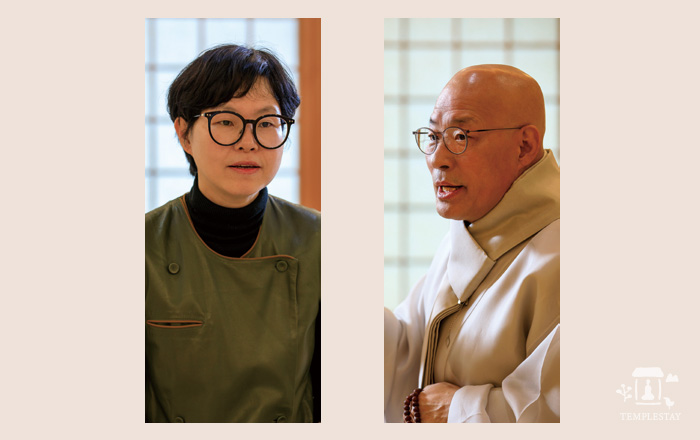
Jinwoo Seunim, reflecting on that time, said, “I felt more like an adult when I was young.” However, what he was really saying is that he had retained the innocence of a boy, perhaps because Wonhyo’ s sincerity had touched his heart so deeply. The grandmother had been single-mindedly waiting for the boy to come home, but when he decided to stay at the temple, she was heartbroken. But having deep faith, she allowed him to continue his path of training.
The boy (now Jinwoo Seunim) read that one book and was inspired to seek enlightenment. Today, he works hard to propagate to the public Seon meditation based on Ganhwa Seon, a traditional Korean Buddhist practice. He recently held a largescale international Seon meditation conference to spread the word about this form of meditation.
He calls it “K-meditation” and emphasizes how it is different from other forms of meditation. He actively works to propagate it through various media platforms, including his books, YouTube, and Seon meditation programs. If this one book aroused in him an aspiration for enlightenment, why is he now focusing on meditation?
He says, “I have never said to stay away from books and do only Seon meditation.”
“In our Seon temples, there is a saying, ‘Sagyo-ipseon (捨敎入禪).’ It means not to be confined by fixed sentences, but to enter a new realm beyond them. ‘Gyo’ is a finger pointing to the moon, and ‘Seon’ refers to the moon. Therefore, don’t just look at the finger, but look at the moon directly.
These days, I emphasize Seon meditation, but that is because one should not just look at the finger pointing to the moon. It doesn’t mean to not read books. When you read a book, you often only focus on the book’s content. If you limit yourself to that, you will not progress past that. That can have the opposite effect of cultivating your mind. In other words, seek your true heart. That’s what it means.”
So, what book would he recommend to someone who wants to learn about Buddhism?
He recommended Jungnonsong (Verses on the Middle Way), translated by Hwang San-deok, the former Minister of Justice, and A Saint Shepherd by Baegun Seunim. The latter, written by Ven. Jinwoo’s own venerable teacher, is a novel about the life of Master Pyeonyang. It is said that Master Pyeonyang Eongi, the dharma heir of Seosan Daesa, is now considered a teacher by 95% of the monastics in the Jogye Order.
Another book is Diamond Sutra Lecture by Shin Socheon. Jinwoo Seunim repeatedly emphasized that he was “really, really moved” by reading this book, and added that his own article on the Diamond Sutra—that he is currently serializing in the Beopbo Shinmun and will be published as a book in March of next year—is based on Shin So-cheon’s Diamond Sutra Lecture.

K-Meditation, Drawing from Experience
What does meditation mean to Jinwoo Seunim?
“I have meditated since I was young. Usually, we think of meditation as sitting meditation, but meditation is ultimately about cultivating Seon, a state where suffering is completely eliminated.
“To eliminate suffering, we must eliminate the delusion of discrimination, and that discrimination manifests as cause and effect. As the Buddha said in the Avataṃsaka Sutra, cause and effect can be explained with the simple statement “Because this arises, that arises.” In other words, when one phenomenon arises, an opposite phenomenon will inevitably arise. Two opposite mental states… They arise in the mind, but they also manifest physically. When the sun rises, the sun must set. When you are born, you must die. In this way, the manifestation of causal relationships is only separated by time. When one thing arises, an opposite thing will inevitably arise, which results from discrimination.
“If you have good traits, you will also have bad traits. The more extreme these traits are, the heavier the karma is. So, if your mind is completely nonjudgemental, stable, and unaffected by the law of cause and effect, your mind will always be at peace.
“So, whether you are standing or lying down, whether you are talking or not, your mind is affected by causes and conditions, but your mind should always be at peace, like water. Water always remains level, and your mind too should be like that. Just as water always remains level, no matter how much you tilt whatever container it is in, your mind should always remain level. That is Seon. That is why we must practice Seon. That is how to avoid suffering.”
I asked, “Will Seon meditation really help me control my mind?” More than anything else, I was curious about Jinwoo Seunim’s experience.
He burst into laughter, saying, “I have much experience in different areas. ‘President of the Jogye Order’ is not just a title. Deciding, resolving, protecting, preventing… everything is the job of the president. If I can’t maintain peace of mind, I’d probably die from stress.”
Looking into the Sea of Suffering
The position of president is the highest office in the Jogye Order. The president must clearly see what’ s going on both inside and outside the Buddhist community, and he must hear everyone’s voice. So, how does the president view the suffering of all living beings.
“If everyone’s heart is not at peace, we will collide, and that will inevitably lead to conflict. These days, people have become materially affluent, but the social environment is not good due to social inequality and some groups being marginalized. In addition, people have become too competitive, and some have to live in difficult circumstances, which leads to deprivation and suffering.
“Just because society is relatively wealthy doesn’t mean that suffering will disappear. People need to have the power to overcome their own suffering, and if they lack that power, they will inevitably suffer.
“The reason for spreading Seon meditation is to enable every citizen, especially every Buddhist to have a Seon mind, a peaceful mind, a mind they have control of. If we do that as a religious order, our Buddhism will be revived, and the number of Buddhists will increase. And if the number of Buddhists increases and they practice the Buddha’ s teachings, society will become more peaceful, and the country will be stronger.”
However, it takes time to resolve one’s suffering with Seon meditation. What can we give those who are suffering now and wanting to know about Buddhism?
“If you just tell people to do something, they won’t know what to do or how to do it. If you want a cow to drink, you have to lead it to water. So, we create various programs at Buddhist expos and provide opportunities like Templestays so young people can be exposed to Buddhism and Seon meditation.
“A while ago, we created a program called “I Go to the Temple” to get young people interested. Once they come and look, they come into contact with many different aspects of Buddhism. Through this, they learn what Buddhism is, what Seon meditation is, and why they should cultivate their minds. Then, they can make their own choices. They decide to try it once and experience it for themselves, and that becomes the reason and purpose for them to practice Buddhism or Seon meditation.”
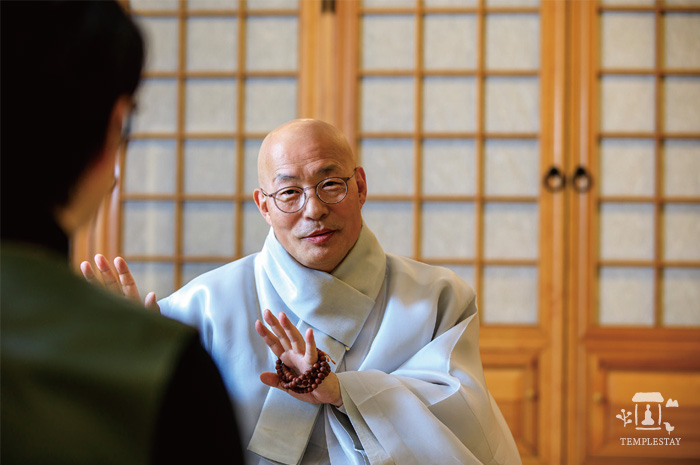
K-Meditation, Toward the Ultimate Solution
In the process of spreading K-meditation, Jinwoo Seunim has met and talked with several worldrenowned meditation experts. In the process, what differences did he see between K-meditation and other forms of meditation?
“The form of meditation that is currently popular in the West is mindfulness meditation, and the program run by Dr. Kabat-Zinn is highly thought of. In the US and Europe, they meditate using various techniques.
However, in my opinion, these may have temporary benefits, but I doubt they will have lasting benefits.
“The K-meditation that I advocate can be likened to providing materials so that various things can be made with those materials. A mind that discriminates is two-sided. If you pursue pleasure, you will experience suffering in equal measure. This is inevitable.
“However, if you look at Western forms of meditation such as mindfulness, they only focus on one aspect: positive, good, beneficial, etc. If you do that, you will never be able to overcome your suffering. When something more positive appears, the previously positive thing becomes relatively less positive. Since this form of meditation is repeated over and over again, I don’t think it is beneficial. Ultimately, issues cannot be resolved through this form of meditation.
“However, the K-Seon meditation that I am advocating now requires that we eliminate discriminating between this side and that side. In order to do that, we must eliminate both opposing emotions that may arise. If we eliminate those, and calm our minds, then cause and effect will not apply.
If we seek something good, something bad will naturally arise, and eventually we will suffer. Don’t have such judgmental thoughts in the first place. In order to do that, we must: calm our minds, see and accept things as they are, consider what has passed as having passed, and stop obsessing over them. That is the greatest benefit of K-Seon meditation.
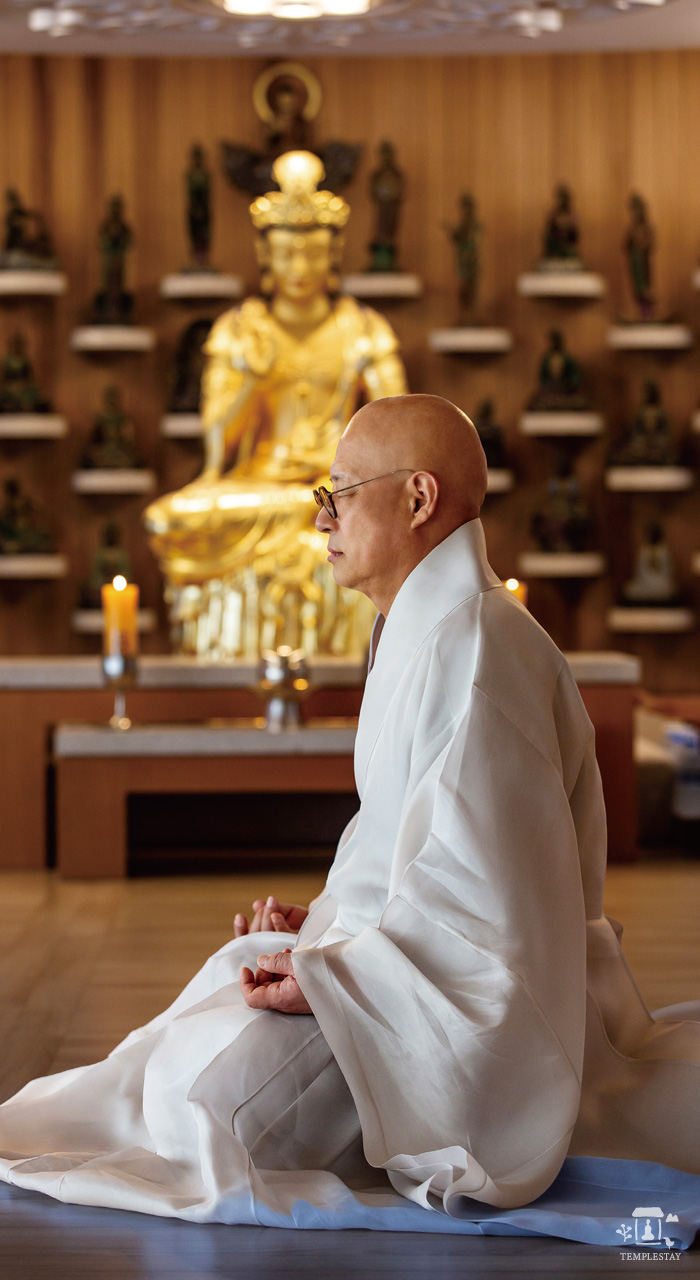
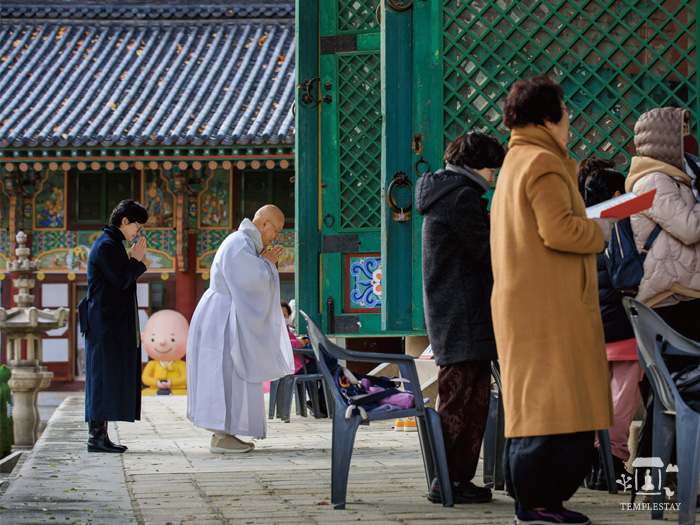
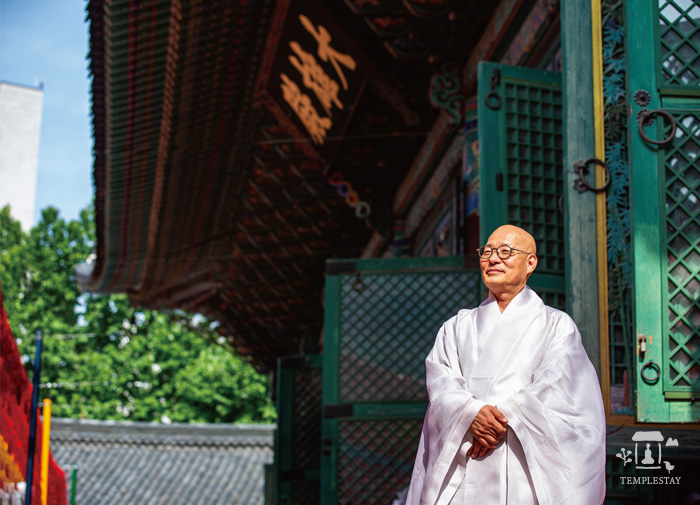
“When emotions are swayed, a vicious cycle of suffering occurs, which Buddhists call transmigration (samsara). In order to avoid that, you must first stop making judgments about what you think is good or bad.
“The world is interconnected and intertwined, including each speck of dust, and everything in the universe is influenced by causal relationships.
Therefore, there is no way to judge what is right or what is wrong, or what is good or bad. Typhoons occur as a natural phenomenon, and so do earthquakes. Since all of these occur due to the law of cause and effect, you cannot identify what is the cause and what is the effect. Therefore, if you are too attached to a person, place, or thing, then your mind will become distracted and/or swayed. Life is simple; when an earthquake occurs, an earthquake occurs, when a typhoon blows, a typhoon blows. You must not let your mind be obsessed by anything. Keep your mind calm and peaceful. That is the essence of Seon.”
But I Want to Be Happy.
Then, what is happiness in Buddhism?
“The concept of happiness in Buddhism is different from what most people think. Most people think that happiness is getting everything they want. They want a lot of money, so they think they have to have money to be happy. People in business have to do well in business to be happy. People who study have to study well to be happy. But that way of thinking leads nowhere. I was born, I want to live long and not die, but that doesn’t mean I won’t die. I’m young now, I don’t want to grow old, but that doesn’t mean I won’t grow old.
“Why are people unhappy and why do they suffer? It is because they hope for the impossible and become disappointed and miserable when that doesn’t happen. That kind of happiness does not exist. But if you keep wanting to be happy, will you be happy?
“You have to eliminate both of these opposing ideas: happiness and unhappiness. That will lead to happiness. That is the teaching of Buddhism. Suppose I do not want to die. Physically, I cannot avoid dying.
However, I can eliminate my fear of death and suffering by cultivating a non-discriminating mind.
“It is natural to be born, to die, to come into being, and to disappear. It is natural on all levels of existence, both mentally and physically. Therefore, when you realize that all things occur naturally, you relax, and your suffering disappears. That is Buddhism. That is how you achieve true happiness.”
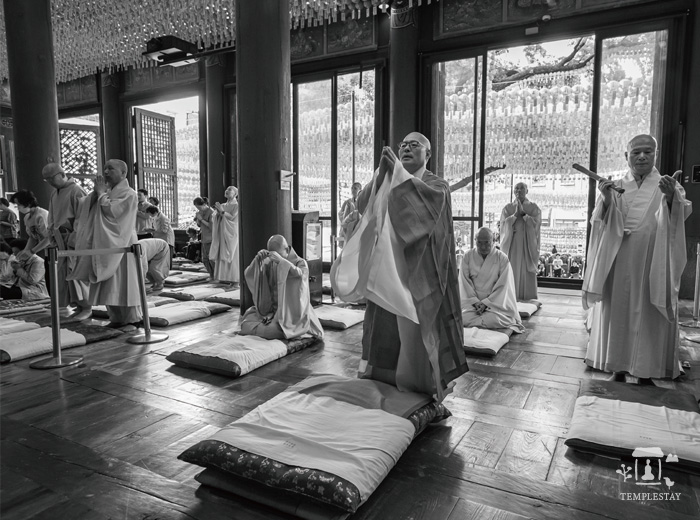
As It Is, Like Flowing Water
After my interview with Jinwoo Seunim, I went to the courtyard of Jogyesa Temple and noticed the raindrops had almost stopped. The devotees who had been praying inside and outside the main buddha hall bowed their heads deeply when they saw Jinwoo Seunim. I looked at the raindrops dripping from the Chinese scholar tree, the chairs that filled the courtyard, and the people entering and exiting the temple for various reasons. And I wondered if my pain would subside if I accepted all of this as it is, just like raindrops that naturally go their own way, following every twist and turn.
Baksa is a book columnist and famous as a “Buddhism geek.”She has introduced others to books and culture through various media including broadcasts and daily newspapers, and has interacted with the public through programs including “Book Listening Night” and “Book Listening Evening.” Her Korean publications include: To Me, Travel, and If You Could Smile Even if Your Chicken Had Only One Leg.
Check out more photos >



